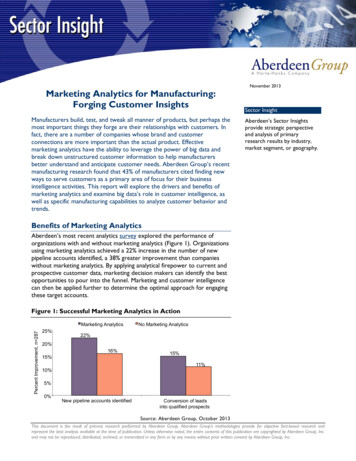
Transcription
Marketing Analytics for Manufacturing:Forging Customer InsightsManufacturers build, test, and tweak all manner of products, but perhaps themost important things they forge are their relationships with customers. Infact, there are a number of companies whose brand and customerconnections are more important than the actual product. Effectivemarketing analytics have the ability to leverage the power of big data andbreak down unstructured customer information to help manufacturersbetter understand and anticipate customer needs. Aberdeen Group’s recentmanufacturing research found that 43% of manufacturers cited finding newways to serve customers as a primary area of focus for their businessintelligence activities. This report will explore the drivers and benefits ofmarketing analytics and examine big data’s role in customer intelligence, aswell as specific manufacturing capabilities to analyze customer behavior andtrends.November 2013Sector InsightAberdeen’s Sector Insightsprovide strategic perspectiveand analysis of primaryresearch results by industry,market segment, or geography.Benefits of Marketing AnalyticsAberdeen’s most recent analytics survey explored the performance oforganizations with and without marketing analytics (Figure 1). Organizationsusing marketing analytics achieved a 22% increase in the number of newpipeline accounts identified, a 38% greater improvement than companieswithout marketing analytics. By applying analytical firepower to current andprospective customer data, marketing decision makers can identify the bestopportunities to pour into the funnel. Marketing and customer intelligencecan then be applied further to determine the optimal approach for engagingthese target accounts.Figure 1: Successful Marketing Analytics in ActionPercent Improvement, n 287Marketing Analytics25%No Marketing Analytics22%20%15%16%15%11%10%5%0%New pipeline accounts identifiedConversion of leadsinto qualified prospectsSource: Aberdeen Group, October 2013This document is the result of primary research performed by Aberdeen Group. Aberdeen Group's methodologies provide for objective fact-based research andrepresent the best analysis available at the time of publication. Unless otherwise noted, the entire contents of this publication are copyrighted by Aberdeen Group, Inc.and may not be reproduced, distributed, archived, or transmitted in any form or by any means without prior written consent by Aberdeen Group, Inc.
Marketing Analytics for Manufacturing: Forging Customer InsightsPage 2In this way, marketing analytics not only reveal fresh leads, but help usherpotential customers along the buyer’s journey. Organizations leveragingmarketing analytics improved their conversion of leads into qualifiedprospects by 15%. By gathering customer intelligence and wielding analyticaltools, marketers can better nurture their leads and decision makers canoptimally manage their tactics and resources to deliver more high qualityprospects to the sales force. By using analytics to help convert customerdiscoveries into prospects and, ultimately, closed sales, organizations cansee how different marketing strategies are impacting the bottom line anddelivering the greatest return on investment (ROI).Changing the ChannelWhen examining the benefits of marketing analytics, it is also valuable tounderstand the driving forces behind analytical initiatives and the problemsmarketers hope to solve using customer intelligence. Aberdeen’s Big Datafor Marketing survey revealed that the top pressures stirring interest inmarketing analytics all relate to understanding and utilizing every channel ofcustomer interaction (Figure 2). Fifty percent (50%) of survey respondentscited shifting buying behavior, such as the use of new channels or a changein buying patterns, as a driver for their investment in marketing analytics.Analyzing shifting behavior can reveal what strategies are swaying customersand what messaging is falling on deaf ears. With customer intelligence tools,marketers can fully understand trends in their historical data and apply thatunderstanding to interpret present conditions and better predict the future.Figure 2: Pressures Driving Marketing Analytics InitiativesShifting buying behavior (use of newchannels, changing buying patterns, etc.)50%Tracking the performance ofvarious digital marketing programs36%All RespondentsProliferation of new marketingchannels (social, mobile, etc.)35%0%10% 20% 30% 40% 50% 60%Percentage of Respondents, n 141Source: Aberdeen Group, October 2013Of these channels, digital channels are of the greatest interest to companiespursuing marketing analytics, with 36% citing tracking the performance ofvarious digital marketing programs as a top pressure. Digital channelsrepresent the fastest growing means of customer interaction, and marketersare investing accordingly. Marketing decision makers want analytics that willshow them what programs are gaining traction with customers and whichones leave something to be desired. Finally, 35% of respondents see 2013 Aberdeen Group.www.aberdeen.comTelephone: 617 854 5200Fax: 617 723 7897
Marketing Analytics for Manufacturing: Forging Customer InsightsPage 3marketing analytics as an answer to the challenge of new marketingchannels. No single channel can offer sufficient insight to mold the idealmarketing strategy. Marketers look for tools that help them understandevery point of customer interaction and method of communication.Marketing analytics can identify any channels where marketers are failing toreach their customers or where their current strategy is deficient.Big Data and Marketing Analytics ToolsAnalyzing customer data across all channels means dealing with a hugeamount of unstructured data, including everything from customer feedbackto social media mentions. Aberdeen’s survey, Data Management in a BigData World, examined the ability of companies with big data capabilities toderive insight from unstructured data using a customer-focused toolset(Figure 3). Seventy-two percent (72%) of organizations with big datacapabilities have social media monitoring tools, compared to just 11% oforganizations that have not invested in big data. Analyzing customer activityon social media allows manufacturers to understand how customersperceive their brand and their products. Big data capabilities are needed toeffectively monitor the volume of unstructured data produced by prospectsand customers every day.“Marketing analytics has givenus the insight to meet, and thenexceed, our customer’sexpectations.” General Manager, Mid-sizedChemical ManufacturerPercentage of Respondents, n 125Figure 3: Big Data Powers Customer Intelligence80%70%Big DataNo Big Data72%60%50%40%40%20%11%10%0%Squeaks and Rattles30%30%0%Social media monitoring toolsCustomer sentimentmonitoring5%Text analytics (singlelanguage)Source: Aberdeen Group, October 2013Big data empowers the tools that allow companies to see how customersare talking about them. In today’s age of social data volume and velocity,customer sentiment monitoring is virtually impossible without some form ofbig data capability to support it. Forty-percent (40%) of big dataorganizations use customer sentiment monitoring, while not a singleorganization without big data capabilities claimed to have such an analyticaltool. Customer sentiment monitoring helps marketers take the temperatureof their customer base. They can also see if their efforts are desirablyshifting the tone of customer conversations about particular products orservices. 2013 Aberdeen Group.www.aberdeen.comAutomotive companies oftenhave a “squeaks and rattles”group. This group specializes incollecting the unstructuredinformation coming fromdealers and other channelsabout vehicle issues that do notget captured through themaintenance systems. Theunstructured data is analyzedand filtered to the plant anddesigners in a continuousfeedback loop. The health ofthis loop typically defines thequality ratings of vehicles.Telephone: 617 854 5200Fax: 617 723 7897
Marketing Analytics for Manufacturing: Forging Customer InsightsPage 4Companies with big data capabilities are six times as likely as those withoutto have text analytics. By analyzing text generated by customers, marketerscan discover patterns and trends in what customers are saying about theirneeds and specific products. Manufacturers can even detect early signs ofproduct quality issues based on a rash of similar complaints or social mediachatter. Between these three tools, big data drives digital engagement,answering one of the top pressures marketers aim to address with analytics.Honing in on the Manufacturing WorldIn some manufacturing sub-industries, the ability to analyze unstructureddata is what takes companies from good to great. Aberdeen’s ManufacturingIntelligence survey asked top performing manufacturers about theirapplication of analytics to customer data (Figure 4). The companies achievingsuperior performance in traditional manufacturing metrics were also theones most likely to integrate customer intelligence into their operationaldecision making (see sidebar). Sixty percent (60%) of Leaders have theability to combine datasets on maintenance and repair claims, returns, earlywarning, safety, and warranty. By combining all this data, manufacturers canrecognize both real and perceived quality or safety issues and take theoptimal steps to correct them. Warranty issues can be quickly addressed oraverted altogether to improve customer experience.Figure 4: Manufacturing Analytical CapabilitiesPercentage of Respondents, n Ability to combine datasets onmaintenance and repair claims, returns,early warning, safety, and warranty5%Ability to use customer knownbehaviors (preferences, likes, etc.)as context for their needsAbility to identify customertrends through social analyticsand new relevant modelsSource: Aberdeen Group, October 2013Some companies, like automotive and consumer goods manufacturers, havebuilt billion dollar organizations around collecting and analyzing structureddata. But the key element they have usually struggled with is theunstructured part. Leaders are 31% more likely than Followers to have theability to use known customer behaviors as context for their needs. Thisability allows manufacturers to integrate customer insight into offermanagement and to better anticipate demand. Finally, Leaders are five timesas likely as Followers to have the ability to identify customer trends throughsocial analytics and new relevant models, revealing this ability as an emergingtrend among top performing manufacturers. These manufacturers are ableto glean patterns from unstructured data to predict future buying patternsand plan their operations accordingly. Decision makers can understand what 2013 Aberdeen Group.www.aberdeen.com Manager, Small IndustrialEquipment ManufacturerLeaders and FollowersAberdeen divided surveyrespondents into two maturityclasses. Classified by their selfreported performance acrossseveral key metrics, Leadersrepresent the top 35% oforganizations and Followersrepresent the bottom 65%. Themetrics considered were: Operational EquipmentEffectiveness (OEE):Leaders – 91%,Followers – 79%46%40%“We apply analytics to all ofour data to identify potentialproblems before ourcustomers do.” On-Time and CompleteShipments:Leaders – 98%,Followers – 88% Operating Margin:Leaders – 18%,Followers – 3% Successful New ProductIntroduction (NPI):Leaders – 95%,Followers – 76%Telephone: 617 854 5200Fax: 617 723 7897
Marketing Analytics for Manufacturing: Forging Customer InsightsPage 5direction different markets are heading in based on customer chatter andactivity.Key TakeawaysThere are no recalls for poor marketing. Manufacturers need to get theircustomer intelligence and messaging right the first time. Top performershave the ability to analyze data from disparate sources to form actionableinsights. Manufacturers hoping to better understand their customers toimprove their marketing efforts and overall performance should keep thefollowing in mind: Marketing analytics help discover new leads and nurtureprospective customers. Compared to companies withoutmarketing analytics, companies using marketing analytics achieved a38% greater increase in new pipeline accounts identified and a 36%greater increase in the conversion of leads into qualified prospectsover the past 12 months. By analyzing market and customer data,marketers can pour more opportunities into the funnel anddetermine the optimal messaging and offers for prospects. Marketers want to understand customer behavior andmarketing performance across all channels. All three toppressures driving marketing analytics initiatives are focused on amulti-channel approach. Manufacturers adopt marketing analytics tomonitor shifting buying patterns and measure the effectiveness ofdifferent marketing programs. Marketers are particularly focused onaiming analytics at digital channels, especially social and mobile. Unstructured data analysis needs help from big data.Manufacturers want to know what customers are saying about theirproducts and overall experience. Seventy-two percent (72%) ofcompanies with big data capabilities have social monitoring tools andonly companies with big data report that they are capable ofcustomer sentiment monitoring. These marketing analytics tools,backed by the power of big data, allow companies to gain keyinsights from unstructured data. Top performing manufacturers draw insight fromcustomers and unstructured data. Manufacturers achievingsuccess in traditional marketing metrics are more likely to haveanalytical capabilities around customers and unstructured data. Sixtypercent (60%) of Leaders are able to combine datasets on multipleareas that impact customer experience, including maintenance andrepair, returns, and warranties. Customer intelligence andunstructured data offer key insights on market trends and futuredemand.As manufacturers mix, press, and weld their way to success, marketinganalytics mold the messaging that will most resonate with customers andkeep them coming back for repeat business. 2013 Aberdeen Group.www.aberdeen.comTelephone: 617 854 5200Fax: 617 723 7897
Marketing Analytics for Manufacturing: Forging Customer InsightsPage 6For more information on this or other research topics, please visitwww.aberdeen.com.Related ResearchBuilding the Analytical Infrastructure forJust-in-Time Marketing; September2013Three Simple Steps to Unlocking theValue of Manufacturing Data; July 2013Asset Management: Using Analytics toDrive Predictive Maintenance; March2013Big Data for Marketing: TargetingSuccess; January 2013Author: Peter Krensky, Senior Research Associate, Business Analytics andBusiness Planning & Execution (peter.krensky@aberdeen.com)For more than two decades, Aberdeen’s research has been helping corporations worldwide become Best-in-Class.Having benchmarked the performance of more than 644,000 companies, Aberdeen is uniquely positioned to provideorganizations with the facts that matter — the facts that enable companies to get ahead and drive results. That’s whyour research is relied on by more than 2.5 million readers in over 40 countries, 90% of the Fortune 1,000, and 93% ofthe Technology 500.As a Harte-Hanks Company, Aberdeen’s research provides insight and analysis to the Harte-Hanks community oflocal, regional, national and international marketing executives. Combined, we help our customers leverage the powerof insight to deliver innovative multichannel marketing programs that drive business-changing results. For additionalinformation, visit Aberdeen http://www.aberdeen.com or call (617) 854-5200, or to learn more about Harte-Hanks, call(800) 456-9748 or go to http://www.harte-hanks.com.This document is the result of primary research performed by Aberdeen Group. Aberdeen Group’s methodologiesprovide for objective fact-based research and represent the best analysis available at the time of publication. Unlessotherwise noted, the entire contents of this publication are copyrighted by Aberdeen Group, Inc. and may not bereproduced, distributed, archived, or transmitted in any form or by any means without prior written consent byAberdeen Group, Inc. (2013a) 2013 Aberdeen Group.www.aberdeen.comSAS and all other SAS Institute Inc. product or service names are registered trademarks or trademarks of SAS Institute Inc. in the USAand other countries. indicates USA registration. Other brand and product names are trademarks of their respective companies.106822 S117055.1113Telephone: 617 854 5200Fax: 617 723 7897
marketing analytics and examine big data's role in customer intelligence, as well as specific manufacturing capabilities to analyze customer behavior and trends. Benefits of Marketing Analytics . Aberdeen's most recent analytics . survey explored the performance of organizations with and without marketing analytics (Figure 1). Organizations










